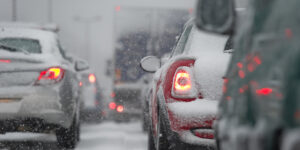Blind spot detection systems use sensors mounted in your side mirrors or on the rear of your vehicle to monitor spaces alongside and behind it. Once detected, when something passes by or in these spaces, warning indicators such as icons in your mirror or audible signals alert you of its presence.
1. Fewer Collisions
Sensors and cameras utilized by blind spot monitoring systems continuously survey the area around your vehicle for hidden objects or vehicles that might otherwise go unseen. When they detect something they alert you either visually or audibly – often by either lights on your side mirrors, dashboard, or chime/beep alerts.
Failure to notice drivers in one’s blind spot can be one of the main causes of car accidents, particularly among larger vehicles like SUVs and trucks. Blind spot detection systems reduce this risk by offering drivers extra visibility; making lane changes safer while monitoring nearby road users easier.
2. Less Accidents
Your driving education instructor likely advised you to check your blind spots prior to changing lanes – an invaluable piece of advice, yet blind spot detection systems make this task faster still.
These systems utilize sensors such as radar or cameras to continuously scan your car’s surroundings for vehicles that could potentially enter its blind spots, alerting you either visually or audibly (usually when your turn signal is activated) to any that are present. They provide visual indicator lights or audible warnings as necessary.
Studies have demonstrated that blind spot detection systems reduce lane-changing accidents by 14% and insurance claims for damage caused to other cars by 23%.
3. Less Damage
Blind spot detection systems utilize sensors and cameras to alert drivers about vehicles that have entered their blind spots, providing this information either on the side mirror or dashboard of their vehicles or as audible warnings.
Keep in mind that these systems should only ever be seen as tools. In order to maximize safety, always check your blind spots by turning your head around and looking over both shoulders.
Maintaining clean sensors and cameras is also key for optimal operation, as this will ensure they function effectively.
4. Less Stress
An unfortunate number of accidents result from drivers failing to notice cars in their blind spots, due to inadequate radar sensors or advanced cameras. Blind spot detection systems help drivers combat this problem by employing radar sensors and cameras with blind spot detection systems that help identify blind spots before accidents happen.
The system can alert you of cars that come too close by flashing lights in the side mirror and/or making sounds. Additionally, it can be linked with your turn signal so that when activated it will also sound an alert for approaching vehicles.
Blind spot monitoring systems have been proven to dramatically decrease lane-change crashes, helping avoid injuries and costly damages while providing peace of mind to drivers prone to road anxiety. They make an ideal solution for new drivers and those dealing with anxiety on the road.
5. Less Accidents for Pedestrians
Sensors used in blind spot detection systems can also detect pedestrians and cyclists. This information is relayed back to the driver who will then be informed that there is someone present within his or her blind spot.
This feature can be especially helpful when switching lanes without wanting to have to look over your shoulder, however, it should not replace adjusting mirrors and conducting a shoulder check.
Studies have demonstrated that BSM reduces lane-change accidents by 14% and those involving injuries by 23%. Many sensors come equipped with rear cross-traffic alert (RCTA), which helps when reverse parking or driveway reversing without visibility of potential side traffic approaching from either direction.
6. Less Accidents for Drivers
Blind spot detection systems utilize sensors or cameras to alert drivers when another vehicle enters their blind spot, providing important protection when changing lanes and avoiding accidents caused by vehicles that the driver hadn’t noticed in his side or rearview mirrors.
The system monitors your car’s immediate area, detecting objects through radar, ultrasonic waves, or cameras. If a vehicle enters your blind spot while you indicate to switch lanes while signaling for them to change lanes, the system warns with flashing lights in your wing mirror or internal front pillar and a chime or vibration of the steering wheel to alert you.
7. Less Accidents for Vehicles
Highway accidents involving lane-change incidents are some of the most prevalent. They can be avoided by using a blind spot detection system and keeping your side mirrors clear, signaling your intentions before changing lanes, and maintaining clean side-view mirrors.
Blind-spot monitoring systems use ultrasonic sensors to detect objects within your car’s blind spot areas and alert you with visual and audio cues of their presence. Many of them come packaged together with rear cross-traffic alert (RCTA) systems which utilize these same ultrasonic sensors to warn of traffic behind at low speeds when backing up in parking lots, for instance.
8. Less Accidents for Cargo
Blind spot detection systems constantly monitor areas that aren’t visible through side mirrors or rearview mirrors of vehicles, using sensors to detect vehicles or objects within these spots, then alert drivers if they attempt to change lanes and may risk an accident by flashing visual indicators like flashing lights on wing-mirrors or dashboards as well as audible alerts.
Blind spot detection systems increase driving safety for everyone on the road by decreasing hazardous lane changes and helping drivers safely load and unload cargo, improving driving safety for everyone on the road. They can also help fleets cut costs by decreasing fuel consumption and improving productivity.
9. Less Accidents for Cargo
Trucks carry cargo that may be difficult to see. Blind spot monitoring systems can assist drivers in avoiding accidents by alerting them when another vehicle approaches nearby, making it easier to change lanes or reverse out of parking spaces without damaging your load.
Under tests, the BLIS system reliably detected an approaching VRU at up to 1.25 meters regardless of the state of activity of its right-hand direction indicator; however, in an accident scenario such as this one, driver notification of this event arrived too late; further research will need to be performed to address this issue and incorporate its results into technical avoidability analyses of this type of accident.




